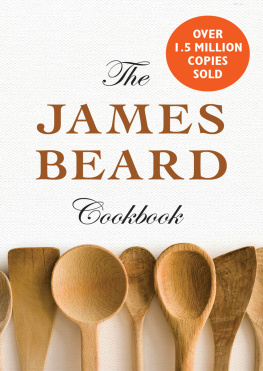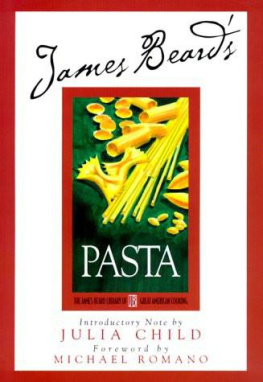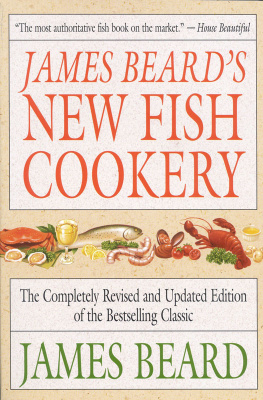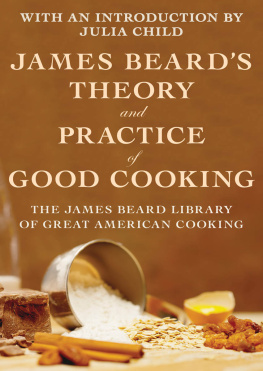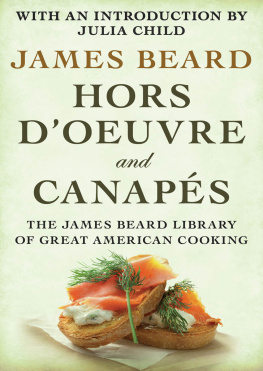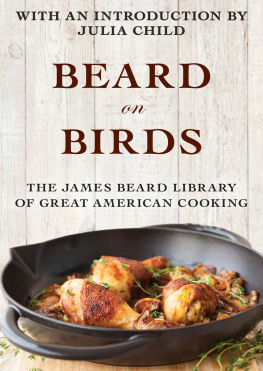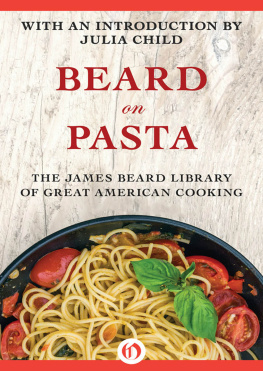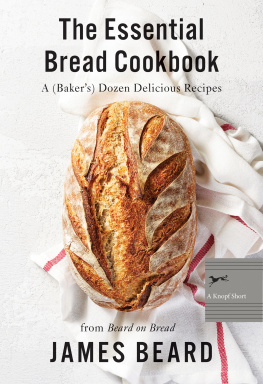The James Beard Cookbook
James Beard

Contents
Editors Note
James Beard made few revisions in the 1966 edition of The James Beard Cookbook. Just seven years after its publication it was still something of a pioneering work, and the great American food revolution was not yet in full motion. But by the time Beards American Cookery was published in 1972, the changes in American eating habits and in national food distribution were enormous. It is hard to remember that sour cream was once an unfamiliar product (readers of the original James Beard Cookbook had to be cautioned to use commercial sour cream, not cream gone sour); that fresh chicken was available from poultry farmers and not every supermarket; and that pasta was still largely a matter of spaghetti, macaroni, and noodles.
Looking back on his first basic cookbook, toward the end of his career Beard noted that it was in need of a complete update. The revisions for this edition may not be as extensive as those he might have undertaken himself, but they will make the book more useful for contemporary cooks without altering its essential character. The fish chapter, for example, now incorporates the Canada Board of Fisheries rule for cooking fish, which Beard adopted in all of his later work. The food processor has been introduced. Some recipes have been deleted or rewritten, and someobvious oversightshave been added. There are numerous other changes throughout, but this is still the book that gave us the courage to eat our lamb pink, brought classic continental dishes such as Choucroute Garnie (a Beard trademark) and Vitello Tonnato into our kitchens, and taught a whole generation of Americans how to eat better that ever before.
John Ferrone
(1987)
Note to the Third Revised Edition
This latest edition of The James Beard Cookbook continues the editorial aims of the previous revisionto keep the recipes workable for todays cooks while preserving the integrity of the original book, but also to take into account James Beards rethinking on such matters as timing and temperatures. Only a handful of recipes have been deleted or replaced, a sign of the books enduring merits. Twenty-five have been addedall qualifying as basic and all, I would like to think, recipes Beard might well have included the first time around.
J.F.
(1995)
Foreword
This is a basic cookbook. It is intended to help two sorts of people: first, those who are just beginning to cook and say they dont even know how to boil water, and second, those who have been trying to cook for a while and wonder why their meals dont taste like mothers cooking or the food in good restaurants.
Anybody who is conscientious enough to follow simple directions can learn to cook. For example, if you are among those who have never boiled water, this is what you do: Fill a saucepan with cold water and put it on the stove. Adjust the burner to high. Let the water heat until it bubbles and surgesand that is boiling water. I assure you in all seriousness that many of the recipes in this book are not much more complicated than these instructions on how to boil water. Most cooking, even of elaborate dishes, is merely the combining of a number of very simple operations.
A lack of knowledge about basic cookery can be somewhat inconvenient. Some years ago young friends of mine started off from New York for several months stay in the Near East. Their luggage consisted mainly of case after case of canned goods, packaged foods and mixes, and dehydrated soups. When all the cases were stacked up on the dock, the scene looked like the receiving platform of a grocery store. The pretty young wife perched herself on a case of soup and explained that they had to take their food with them because she wouldnt know how to cope with the produce sold in Near Eastern markets. She had never really cooked, she admitted, except to fry hamburgers and use mixes and frozen dinners.
Now, mixes and frozen foods can be helpful when time is precious and shortcuts are necessary. But youll never achieve confidence in your cooking ability if your culinary skill depends on using ingredients that someone else has mixed or seasoned or pre-cooked. Like almost everything elsewalking, driving a car, painting a pictureyou learn best by doing.
There are three very good reasons why you should learn basic cookery: practical, gastronomical and personal reasons. On the practical side, its a stubborn economic fact that preparing your own food is cheaper than buying it ready-made. Gastronomically, its a fact that home cooking is tastier and more varied. As for the personal side, its a fact that cooking is fun, especially good cooking.
Cooking is one everyday task that can be creative. You become a creative cook by first becoming a good basic cook. Your transition from basic to creative cooking takes some doing, some actual experience in finding out what happens when you add this or change that. Once you have made this transition, you will never lack admirers. Good food has a magic appeal. You may grow old, even ugly, but if you are a good cook, people will always find the path to your door.
J AMES B EARD
(1959)
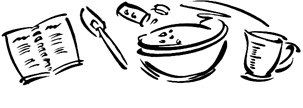
C OOKING T OOLS AND T ERMS
Basic Cooking Equipment
KNIVES
Large carving knife
Large chefs knife with 10- or 12-inch blade
Chefs knife with 8-inch blade
Slicing knife
Boning knife
Paring knives
Small knives for general use
Serrated bread knife
Grapefruit knife
Sharpening steel
SPOONS AND FORKS
Wooden spoons of various sizes
Slotted or perforated spoon
Long-handled spoon for basting and stirring
2 or 3 regular kitchen spoons
Ladle
Measuring spoons
Fork and spoon for tossing salad
1 large two-pronged fork
2 or 3 regular kitchen forks
Small fork for removing items from small-necked bottles
CARVING AND CHOPPING BOARDS
Large carving board, about 16 inches
Smaller carving board, about 12 inches
Small chopping boards
Chopping block
Pastry board
Bread board
DISHES AND BOWLS
Nest of mixing bowls of various sizes
Souffl dishes
Molds of various sizes
1 or 2 kitchen platters
Ovenproof serving dishes
Shallow baking dishes
Individual ramekins and pudding molds
POTS AND PANS
Saucepans of various sizes, with lids
Double boiler
Enamel pan for boiling eggs
Large, deep braising pan with tight lid
Teakettle
Steamer with rack
Medium-sized saut pan with lid
Large, heavy saut pan with lid
Skillets of various sizes
Pan and basket for deep-frying
Griddle
Crpe pan
Omelet pan
Roasting pan and rack
2 or 3 casseroles of various sizes
Loaf pans
Ring mold
Baking sheets
Tube cake pan
Cake tins
Jelly roll pan
Muffin tins
Pie tins
Flan pans with removable bottoms
Flan rings
Deep dish for quiches and pies
OTHER TOOLS
Apple corer
Ball scoop
Biscuit cutters
Bottle opener
Cake racks
Can opener
Candy thermometer
Corkscrew
Deep-fat thermometer
Eggbeater
Food mill
Funnel
Grater
Kitchen scale
Kitchen scissors
Lemon squeezer
Measuring cups, for liquid and dry measure
Meat thermometer
Mortar and pestle
Pastry brush
Pastry tube and attachments
Next page
